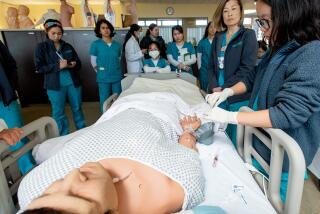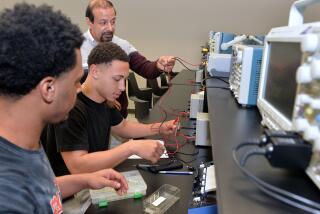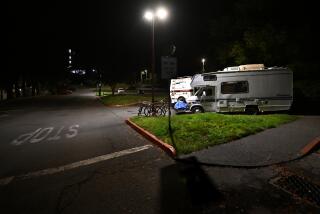Tips for the College-Bound and Confused : The ins and outs of locating parking, buying books and finding your way to class.
- Share via
It may feel like summer, but August marks the beginning of the fall semester at local colleges. If you are a fresh man or a returning student who has been away from school for several years, here are some tips to help you through the semester.
Getting Around
College campuses are big--Cal State Northridge has 20 major buildings on more than 350 acres. Their sheer size is enough to intimidate any new student. To avoid getting lost on the first day of school, Harry Howard, a student peer adviser of the Pierce College counseling office, suggests becoming familiar with the Woodland Hills campus before classes begin.
“Come over on a Friday afternoon when the campus is at its slowest, and learn the lay of the land,” he says. It’s also a good idea to keep a campus map, printed in schedules and catalogues, tucked in your notebook.
But knowing your way around won’t do any good if you can’t get out of your car. Students at local college say you have almost no chance of finding a parking space near class.
“Your best bet is to ride your bike,” says Wendy Yost, a CSUN junior who works as a student orientation director. “Parking is expensive at CSUN--$63 a semester--and even if you pay for it, you are not guaranteed a spot.” About 30,000 students will vie for fewer than 12,000 spaces this fall.
Parking permits at community colleges are a better buy at $20, and spaces are available for students who don’t mind taking a hike. “Parking really got bad last year,” says Richard Carpenter, who was active in student affairs at College of the Canyons in Valencia until he graduated in June. “But there is always a space in the farthest lot. Arrive a half-hour before your class because it’s a good 15-minute walk,” says Carpenter.
Filling Your Schedule
Many schools are responding to the state budget crises by cutting hundreds of classes. At CSUN, about 675 have been sliced.
But most English, math and other general education courses, which are required for graduation, have been closed for months. At Canyons, “all English, history, political science, geology, biology and art classes are full, and the majority of them have a waiting list of 10 students each,” says Registrar Dottie Duncan. “Only one anthropology class that holds 80 students is open, and that is almost closed. The only classes that are open are the specialty courses, such as music and German.”
How will you ever get the courses you need?
“Students should be as flexible as possible,” says Audrey Green, counselor and matriculation coordinator at Canyons. “Take classes in the late afternoons or evenings. Have a split schedule. If the class you want is closed, there may be other options that satisfy your requirements.”
Persistent students may be able to crash a full class, according to Howard. “Get on the waiting list,” he says. “Then, even if you are at the very bottom of the list, go to the class two or three times, not just once.”
Howard explains that if enough enrolled students drop during the first few weeks, instructors usually add those from the waiting list.
Many instructors also automatically drop anyone absent the first day of school to make room for students who want to add the class.
But don’t overload your schedule, says Valley College counselor Ann Morris, director of the career transfer center in Van Nuys. “The worst mistake new students make is taking more classes than they can handle,” she says.
According to Morris, a typical course requires about six hours of homework weekly, in addition to the time a student spends in class. “Most of our students have to work,” she says. “Full-time workers should attempt no more than two classes,” she says. A full load is considered 12 units, each representing an hour in class.
Get Help
Most schools offer classes and free services to help students succeed. Career and transfer centers at all schools provide job information and university requirements. At Valley, a short, one-unit course called Introduction to College teaches students academic and career planning and study skills. Pierce and Canyons students can learn library research skills in a one-unit, self-paced course. Help in math and writing is available at CSUN’s Learning Resource Center.
Contact a counselor early in the semester for help establishing a schedule. “It is important to develop an educational plan,” Green says. “Students tend to flounder when they don’t have a direction or a goal.”
Instructors also are willing to help students.
“Stop by during your instructors’ office hours and let them know who you are,” says CSUN student Yost. “Last semester, I was completely overwhelmed in a physiology course. I voiced my concerns with the instructor, and he just talked for hours about what he expected and how to study for his class.”
Hit the Books
Textbooks are a major expense--the average textbook costs between $30-$35 and many classes require more than one book. To reduce sticker shock, keep your eyes open for used texts in decent shape.
During the first week of school, you may need an appointment to get in the bookstore. Once inside, prepare to stand in a long line.
Students can avoid the crush by shopping before classes begin.
But Carpenter suggests putting off investing hundreds of dollars in books until you are sure you like your classes.
Join the Club
Every college offers dozens of social, religious, political and academic organizations. Pick one or two and join.
“Getting involved on campus is an excellent way to learn more about school,” says Howard, co-president of the Lesbian and Gay Organized Students.






